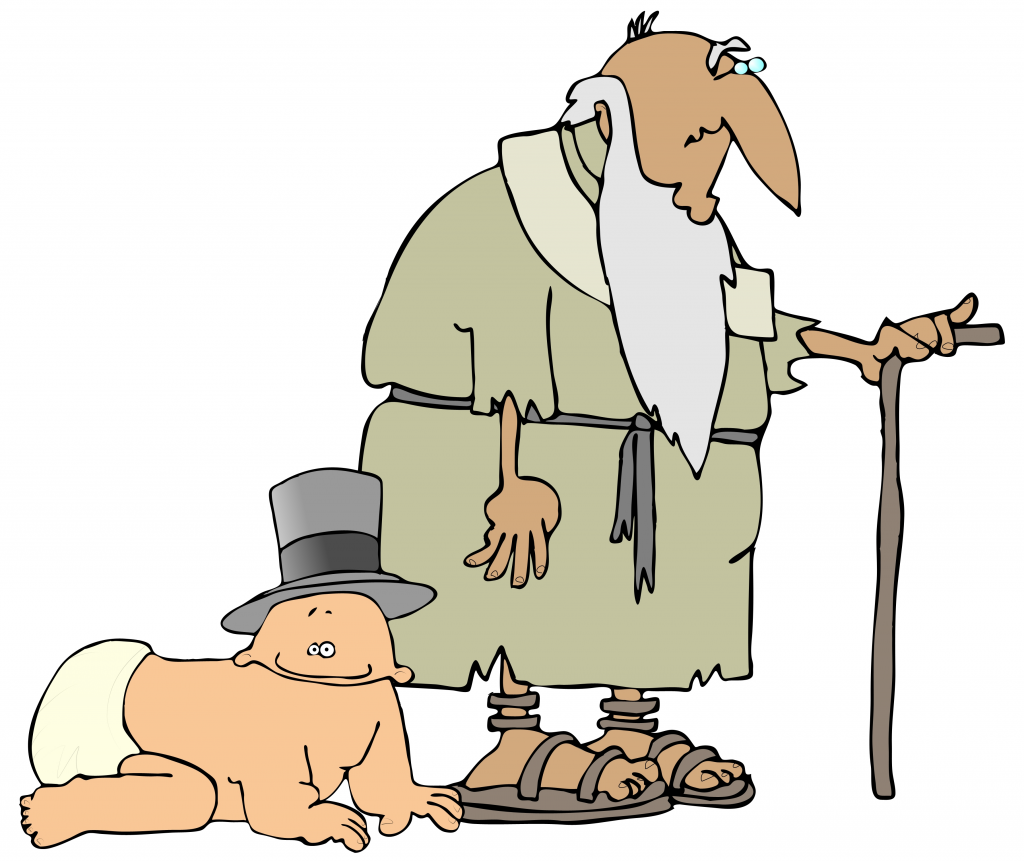Goodbye and good riddance. Undoubtedly, those are the sentiments of many people as they greet the New Year. Journalist David Andreatta (@david_andreatta) stated it about as bluntly as you can, “What a f***** up year. I apologize for the language. I do. You expect more from a wordsmith. I know. But there’s really no other way to sum up 2020.”[1] Admittedly, 2020 was a tough year for most of us and putting it in our rear-view mirror will come with little sadness. Gautama Buddha once stated, “No matter how hard the past, you can always begin again.” That may be an old sentiment, but it rings as true today as when it was first uttered. We all recognize traditional symbols of an old man and a baby as the embodiment of the passing of the old year and the birth of a new year. Instead of dwelling on the past, let’s focus on something more fun: babies.
For millennia, the New Year has been represented by a baby. CNN correspondent Lisa Rose explains, “The New Year’s baby is a cultural mainstay that dates back as far as ancient Greece, when a child was paraded around in a basket to welcome the new year.”[2] Of course, those babies weren’t wearing a top hat and sash like Baby New Year is now often depicted. That tradition has a much more modern beginning. Rose writes, “A cherub in a top hat, sash and diaper, Baby New Year is an avatar of optimism as the clock ticks down to midnight on December 31. The black-capped toddler has been a holiday staple since the dawn of the 20th century, when the Saturday Evening Post began publishing humorous illustrations of babies on the covers of its year-end editions. The magazine covers inspired grownups to dress like infants on New Year’s Eve in frequently ill-fated attempts to be the life of the party. Although the Saturday Evening Post ended its New Year’s baby series in 1943, the pint-sized personification of time’s passage continues to loom large in pop culture.” Rose goes on to discuss a few “fun facts” about Baby New Year.
Fun Fact 1. Baby New Year began as the representation of the rebirth of Dionysus. New Year celebrations have apparently always been accompanied by heavy drinking. Rose reports, “During the age of Plato and Socrates, Greeks ushered in the new year with celebrations honoring Dionysus, the son of Zeus and god of wine. One of their traditions was placing an infant in a winnowing basket and hoisting the child skyward to represent the rebirth of Dionysus.” Let’s be honest. Drunks hoisting babies in the air doesn’t sound particularly safe.
Fun Fact 2. Big Baby survived a hurricane. According to Rose, a 6-foot-tall papier maché baby adorned the roof of the Jax Brewery in New Orleans for sixteen years (2000-2016). It was retired to the Southern Food & Beverage Museum after its final appearance having survived Hurricane Katrina. According to Rose, the holiday behemoth often wore untraditional attire such as a New Orleans Saints football helmet or a purple and gold Louisiana State University diaper.
Fun Fact 3. Baby New Year and Father Time are BFFs. Rose writes, “Baby New Year is frequently accompanied by Father Time, a cloaked old man who carries an hourglass and a scythe. He is modeled after Cronus, the father of Zeus in Greek mythology. When Baby New Year was popularized in 19th-century editorial cartoons, Father Time tagged along as his elderly counterpart, a symbol of the past year. According to the cartoons, Baby New Year ages rapidly over 12 months, and by the end of December, he’s Father Time.”
Fun Fact 4. Jesus represented Baby New Year in Germany. Christianity often adopted and adapted festivals and traditions from other religions. According to Rose, Germans took the Baby New Year tradition started in Greece and Christianized it. She explains, “About 500 years ago, German artisans created New Year’s greeting cards with drawings of Baby Jesus, according to Christopher Wood, professor of German and department chair at New York University. One of the cards, part of the collection at the National Gallery of Art, depicts a young Jesus riding a donkey with an inscription that translates into ‘I bring a good year.’ Over time, the religious baby Jesus morphed into the secular Baby New Year, according to Wood.”
Fun Fact 5. Baby New Year may have been the first poster child. A poster child is a person that epitomizes or represents a specified quality or cause. Since babies have personified the new year for millennia, you might say Baby New Year was the first poster child. Rose writes, “Baby New Year graduated from newspaper cartoons to magazine covers in 1906, when the Saturday Evening Post published its first holiday illustration of a toddler by artist Joseph Christian Leyendecker. He continued drawing cherubs through 1943, reimagining Baby New Year as an emblem of American resilience. Early on, Leyendecker drew classical pictures of red-cheeked kids with angel wings, but as the world grew more complex, he added darker elements, depicting Baby New Year as a soldier, women’s suffrage activist, striking coal miner, nervous stockbroker and heroic tax cutter. In 1936, when it seemed like the economy was gaining strength after years of decline, Leyendecker drew a top-hatted toddler showered with confetti. Although the recovery didn’t last, the image was indelible.”
Fun Fact 6. Dressing like Baby New Year makes men in diapers acceptable one night each year. Dressing like a baby is often associated with paraphilic infantilism. Paraphilic infantilism, also known as autonepiophilia, psychosexual infantilism and adult baby syndrome, is a sexual fetish that involves role-playing a regression to an infant-like state. Behaviors may include drinking from a bottle or wearing diapers (diaper fetishism). On New Year’s Eve, however, wearing diapers and dressing like a baby isn’t considered a syndrome. Rose reports, “Phish drummer Jon Fishman brazenly took the stage in a bonnet and diaper at Madison Square Garden on New Year’s Eve 1995. Another jam band, Leftover Salmon, recruited a friend to portray Baby New Year for one of their holiday shows.” Now you know how to be the life of the party — once you can safely attend parties that is.
Fun Fact 7. New Year’s babies are often feted. The first child born on New Year’s Day in Germany is called Neujahrsbaby. In many states in America, the fist baby born in the new year is showered with gifts from local merchants. Rose reports, “It’s a tradition for newspapers to spotlight babies born on January 1. The task of locating the year’s first child has grown more complex. In the past, hospitals publicized birth announcements, but these days, many health care facilities have ceased sharing info with the media because of concerns about identity theft and privacy on the Internet.”
With vaccines now being shipped and inoculations taking place, 2021 looks to be a brighter year as we look forward to a new normal. I like what Nido Qubein (@NidoQubein), President of High Point University, has to say about the future, “Your present circumstances don’t determine where you can go. They merely determine where you start.” Wherever you are starting from, I hope you have a Happy and Prosperous New Year.
Footnotes
[1] David Andreatta, “Saying goodbye, and good riddance, to 2020,” Rochester City Newspaper, 4 December 2020.
[2] Lisa Rose, “How ‘Baby New Year’ was born,” CNN, 11 January 2018.





